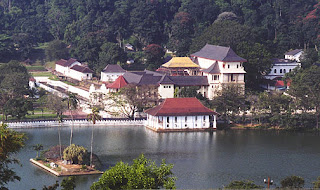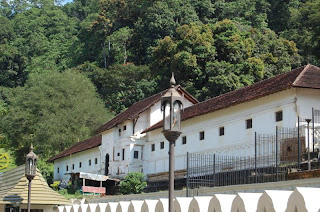Kandy served as the capital of the last Sinhalese kingdom, which fell to the British in 1815 after defying the Portuguese and Dutch for three centuries. It took the British 11 years to build a road linking Kandy with Colombo, a task they finally completed in 1831.
The town, and the countryside around it, is lush and green and there are many pleasant walks from the town and further afield. The town centre, close to Kandy’s picturesque lake set in a bowl of hills, is a delightful jumble of old shops, antique and gemstone specialists, a bustling market and a very good selection of hotels, guesthouses and restaurants. As night falls the city becomes eerily quiet.Kandy is particularly well known for the great Kandy Esala Perahera, held over 10 days leading up to the Nikini poya (full moon) at the end of the month of Esala (July/August), but has enough attractions to justify a visit at any time of year.
Locally, Kandy is known as either Maha Nuwara (Great City) or just Nuwara (City), which is what some conductors on Kandy-bound buses call out.Kandy, the last royal capital of Sri Lanka is a major tourist destination. ( 115kM from Colombo at 465 meters above sea level). Famous for the Temple of the Tooth and many other temples the city could be called the cultural capital of the island.
Kandy Perahera, the pageant of the temple of tooth where Buddha's tooth is kept is held either in July or August each year to parade the golden caskets is a must see itenary if one is visiting Sri Lanka during these months. The final night procession is the most spectacular event of the country. More than 50 elephants parade the city accompanied by the drummers, dancers and chieftains.
he city established in the 15th century was the last royal capital where 2500 years of royal rule ended. This bustling market town is rich in cultural diversity has plenty of iteneries to offer to the tourists from songs dances and handy crafts to ancient temples and adventure activities. Kandy is a good transit point to the cultural triangle to the north or hill country to the south. The city is also a good source of souvenirs or to experience many cultural performances at it's various hotels in the city.
The Temple of Tooth
The main attraction of the city and also the most sacred Buddhist establishment in Sri Lanka is where one of Buddha's tooth is being kept. Built in the 16th century but improvements and additions have been done to this structure until the fall of the Kandy kingdom. A golden canopy was added recently. Daily rituals are being carried out at various offering times to the shrine. A dress code applies for entering the temple. The magnificence has been enhanced by the octagonal pavilion.
The Old Royal Palace compound
Old place buildings are just beside the temple of the tooth. Among them are the old royal palace, quarters of the royal concubines; queen's chambers the council chambers and the armoury. Some of these are now being used as museums depicting the exhibits of the Kandyan era. The council chambers built in 1784 is a unique example of wooden architecture of the Kandyan period. The Kandyan Convention was signed here ceding the country to the British in 1815.
Other Temples
Kandy is surrounded with many major Buddhist temples. On the shores of the lake are Malwaththa and Asgiri temples. Fine painted murals of Buddhist stories in these temple buildings are a good example of the arts in the Kandy period while paintings of the Hindagala temple at Peradeniya are of the 7th century.
Hindu Shrines
Adjacent to the Temple of the tooth are three of the four major Hindu shrines taking part in the Kandy Perahera. Shrines are dedicated to Gods Vishnu and Natha and Goddess Patthini. The forth shrine is further towards the town. Visitors to these shrines could witness the Hindu religion customs though most of the worshipers today are Buddhists. Hindu shrines taking part in the Buddhist pageant is a good example of the Sinhala and Tamil co-existence that lasted for centuries. Four of the last Sri Lankan kings were of south Indian origin.
The Royal Botanical Gardens
Once a pleasure gardens of a Kandyan Queen this 40ha land is a beautiful park with numerous tropical foliage and the best in the island. The Commander of the allied forces in Southeast Asia Earl Mountbatten had the headquarters in the garden during the Second World War.
Peradeniya Royal Botanical Gardens
Peradeniya Royal Botanical Gardens, the finest of its kind in Asia, the largest of the botanical gardens of Sri Lanka, couldn't be better located. In the Mediterranean climate of Kandy, the gateway to the Central Highlands, the Gardens, at an elevation of 500 meters above sea-level, were tightly bounded on three sides by a loop of River Mahaweli (Great sandy river), the largest river of Sri Lanka.
The town of Peradeniya is located at a distance of 110km from Colombo and another 6km over the Peradeniya Birdge and you are at Kandy, home to the sacred Temple of tooth.
The town of Peradeniya is located at a distance of 110km from Colombo and another 6km over the Peradeniya Birdge and you are at Kandy, home to the sacred Temple of tooth.
Gadaladeniya Temple
This 14 century temple is situated about 15Km from the town. The structure of the temple is influenced by the South Indian architecture and built on a rock. The stupa is on a high stone platform.
Embekke Temples
The main attraction is the intricate wooden carvings of this 14th century shrine dedicated to God Kataragama. There is also a Buddhist temple on location. Almost the entire structures of some wooden buildings are decorated with dancers, musicians, wrestlers, legendary beasts and birds. Nearby are the ruins of an ancient rest house with similar pillars carved in stone.
Lankatilaka Temple
Lankatilake temple is a magnificent building built on rock at a scenic location which also has fine paintings.
Arts and Crafts
Kandy is synonymous with arts and crafts of Sri Lanka than anywhere else in the country. It is probably because the Kandy is where all elite who patronised these crafts survived during 300 years of war with the Europeans. Kandy is probably the best place to buy most of the handicrafts produced in Sri Lanka because there are number of shops catering to the tourists. Tourists could watch local crafts coming into life at the At the Kandyan Art Association.
At Kundasale, about 4km from Kandy, a village has been established recently to settle local craftsmen and their families. Visitors could watch craftmen at work and purchase their products on site.
Mask Making
To and From Kandy
Kandy is served by bus from almost all parts of the county with many intercity busses. Travel time from Colombo is about 2.5hrs and about 2 hours form Nuwara Eliya and an hour and a half from Sigiriya.
Distances From Kandy in km
Colombo 116
Anuradhapura 138
Nuwara Eliya 77
Trincomalee 182
There is an intercity train service from the Colombo fort railway station and the travel time is approximately about 2 hours.There are several car rental companies operating from Kandy should your prefer to hire a car from Kandy.





































well done madhu lassanata karala thiyanawa oya
ReplyDelete